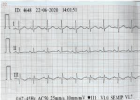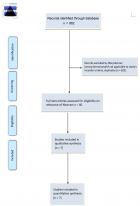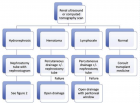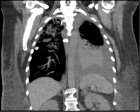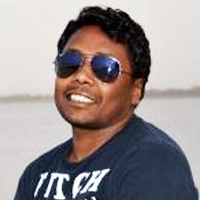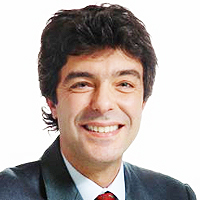Abstract
Research Article
Diseases of the mental sphere revealed by the psychiatrist at contingent of patients of the consultative outpatient admission
Shapovalova LA* and Shapovalov КA
Published: 09 July, 2019 | Volume 3 - Issue 1 | Pages: 012-019
Introduction: The problem of protecting and strengthening the mental health of the population is the most important task of ensuring the socio-economic well-being of the Komi Republic (RK) as an integral part of the Russian Federation (RF), since it is a key resource for the development of a subarctic region.
The aim of the work: was to characterize diseases of the mental sphere revealed by the psychiatrist at contingent of patients of the consultative outpatient admission at the 1State Autonomous Health Agency of the Republic of Komi “Consultative and Diagnostic Center of the Republic of Komi” (SAHA RK “CDC”) of the subarctic territory.
Materials and methods: The analysis of a continuous sample of 6255 patients of the psychiatrist of the consultative department in 2015-2017 was carried out. on the basis of medical records. Analysis methods included: analytical and statistical. The control group consisted of a continuous sample of 5,356 psychiatric patients in 2010–2012. The depth of the study was 8 years.
Discussion: Trends in changes in demographic indicators, including gender and age, in the structure of patients of a psychiatrist in an outpatient consultative procedure are considered. Indicators of the identified pathology of the mental sphere, including the first identified and pathology in patients suffering from epilepsy in comparison with the control group are given. Attention is paid to the organizational and methodological work of an outpatient counseling psychiatrist on the targeted identification by internists of signs of mental pathology in patients referred to a diagnostic center with somatic diseases. Priorities for the improvement of specialized advisory (including psychiatric) assistance to the population of the RK and ensuring its quality were identified.
Conclusions:
1. The psychiatrist of the advisory department in 2015-2017. 6255 people were accepted (889 more than in the control group of 2010-2012). The increase was 16.78%. Primary patients account for 64.38% of the total number of people who applied to a psychiatrist (4027 people).
2. In the structure of the psychiatric pathology of the outpatient psychiatric appointment, the proportion of organic, including symptomatic, mental disorders (F00-F09) is 47.9±0.6%; neurotic, stress-related and somatoform disorders (F40-F49) - 39.6±0.6%; mental and behavioral disorders associated with the use of psychoactive substances (F10-F19) - 3.5±0.2%; mood disorders (affective disorders) (F30-F39) - 2.8±0.2%.
3. The most frequently detected pathologies in patients with epilepsy are: 1) Mild cognitive impairment; 2) Personality disorders; 3) Organic emotionally labile (asthenic) disorders. Their share annually accounts for 71.5%-75.8% of all types of nosological forms. The fourth and fifth ranking places are taken by: 4) Organic anxiety disorders; 5) Non-psychotic depressive disorders. Rarely diagnoses are established: “Organic Amnesia Syndrome” and “Dementia”.
4. Organic, including symptomatic, mental disorders prevail in the structure of newly discovered mental disorders; neurotic, stress-related and somatoform disorders (up to 87.7%). Mental and behavioral disorders associated with the use of psychoactive substances and mood disorders (affective disorders) do not exceed 8.4%.
Read Full Article HTML DOI: 10.29328/journal.apmh.1001005 Cite this Article Read Full Article PDF
Keywords:
Outpatient admission; Psychiatrist; Advisory department; Regional diagnostic center; Subarctic territory
References
- Shapovalova LA. Analiz raboty vracha-psihiatra konsul'tativnogo otdeleniya gosudarstvennogo avtonomnogo uchrezhdeniya zdravoohraneniya Respubliki Komi «Konsul'tativno-diagnosticheskij centr Respubliki Komi». 2012; 53.
- Shapovalova LA., Shapovalov KA. Outpatient Consulting Care of Psychiatrist on Population of SubArctic territory. RC Psych International Congress. 2016.
- Shapovalova LA, Shapovalov KA. Osobennosti organizacii raboty psihiatra regional'nogo konsul'tativno-diagnosticheskogo centra subarkticheskoj territorii. Nezavisimyj psihiatricheskij zhurnal. 2016; 83-84.
- Shapovalova LA. Analiz raboty vracha-psihiatra konsul'tativnogo otdeleniya gosudarstvennogo avtonomnogo uchrezhdeniya zdravoohraneniya Respubliki Komi «Konsul'tativno-diagnosticheskij centr Respubliki Komi». 2018: 1-96.
- Shapovalova LA, Shapovalov KA. Questions of the Organization and Results of the Work of Psychiatrist of Advisory Department of the Regional Diagnostic Center of Sub-Arctic Territory with Low Population Density. Geneva: World Health Organization 13; 2016: 1-25.
- Shapovalov K, Shapovalova L. EV0534 Demographic Characteristics of the Cohort of Patients, Receiving Outpatient Psychiatric Help in Regional Medical Consultative and Diagnostic Center of Sub-Arctic Territory. European Psychiatry the Journal of the European Psychiatric Association: EPA 2017 25th European Congress of Psychiatry. 1-4 April, 2017. Florence, Italy. 2017; 41: 578.
- Shapovalov K, Shapovalova L. EV0535 Structure of Psychic Sphere Pathology of Patients of the Regional Medical Consultative and Diagnostic Center of Sub-Arctic Territory. European Psychiatry the Journal of the European Psychiatric Association: EPA 2017 25th European Congress of Psychiatry. 1-4 April, 2017. Florence, Italy. 2017; 41: 578-579.
- Shapovalova L, Shapovalov K. Approbation of new drugs and treatment methods into practice of outpatient psychiatrist at regional diagnostic center of subarctic territory. Scientific program ep03 e-posters - February 25-28 exhibition hours. Innovations in treatment and recovery: innovative pharmacological treatments. 2018; 18:15 19:15.
- Shapovalova L, Shapovalov K. EV0828 Pathology of the psychic sphere in patients with epilepsy, revealed by psychiatrist of the regional consultative center of the subarctic territory. European Psychiatry the Journal of the European Psychiatric Association: EPA 2018 26th European Congress of Psychiatry. 3-6 March, 2018. Nice, France. Abstracts of the 26th European Congress of Psychiatry. 2018; 48: 718-719.
- Shapovalova L, Shapovalov K. EV0364 Features pathology newly diagnosed by a psychiatrist at the reception of the regional advisory diagnostic center of subarctic territory. European Psychiatry the Journal of the European Psychiatric Association: EPA 2018 26th European Congress of Psychiatry. 3-6 March, 2018. Nice, France. Abstracts of the 26th European Congress of Psychiatry. 2018; 48: 569.
- Shapovalov K, Shapovalova L. EV0940 Scientific research as an integral part of the work of a psychiatrist leading an outpatient consultation in the regional diagnostic center of the subarctic territory // European Psychiatry the Journal of the European Psychiatric Association: EPA 2018 26th European Congress of Psychiatry. 3-6 March, 2018. Nice, France. 2018; 48: 755-756.
- Shapovalova L, Shapovalov K. Training of psychiatrist of regional diagnostic center of subarctic territory for work in emergency situations of catastrophes and natural disasters. Scientific program sc23 innovations in policy and planning health. Short communications 23: migration and depression and emotional status of stroke survivors, and their daily activities and validation of a widely-used depression scale. 2018; 16: 45.
- Shapovalova L, Shapovalov К. E-PV0437 Characteristics of mental health of patients of outpatient reception of psychiatrist. EPA. European Psychiatry. The Journal of the European Psychiatric Association. Abstracts of the 27th European Congress of Psychiatry. Warsaw, Poland. 2019; 56: 582-583.
- Shapovalova LA, Shapovalov KA. Organizational and methodical work as an integral part of the qualification category of a psychiatrist of consultative department of the regional diagnostic center of the subarctic territory. Mental Health. 2018; 7: 3-11.
- Shapovalova L, Shapovalov К. E-PV0342 Organizational and methodological work in the practice of psychiatric outpatient consultative reception. EPA. European Psychiatry. The Journal of the European Psychiatric Association. Abstracts of the 27th European Congress of Psychiatry. Warsaw, Poland. 2019; 56: 552.
- Shapovalova LA, Shapovalov КА. Characteristics of the pathology of the mental sphere of a contingent of patients on an outpatient visit to a psychiatrist of the consultative and diagnostic center of the subarctic territory. Psychiatry, Psychotherapy and Clinical Psychology. 2018; 9: 515-533.
- Shapovalova LA, Shapovalov KA. The structure of the mental incidence of patients of psychiatrist consultative outpatient admission. Geneva: World Health Organization (Pubrights). 2019; 30: 1-26.
Similar Articles
-
Diseases of the mental sphere revealed by the psychiatrist at contingent of patients of the consultative outpatient admissionShapovalova LA*,Shapovalov КA. Diseases of the mental sphere revealed by the psychiatrist at contingent of patients of the consultative outpatient admission. . 2019 doi: 10.29328/journal.apmh.1001005; 3: 012-019
-
Psychotropic drugs prescription block the positive effects of the doctor-patient communication and relationshipJose Luis Turabian*. Psychotropic drugs prescription block the positive effects of the doctor-patient communication and relationship. . 2021 doi: 10.29328/journal.apmh.1001029; 5: 014-017
-
Regulatory requirements and assessment of scientific research by a psychiatrist when considering the issue of assigning a qualifying doctor`s categoryShapovalov KA*,Shapovalova PK,Shapovalova LA. Regulatory requirements and assessment of scientific research by a psychiatrist when considering the issue of assigning a qualifying doctor`s category. . 2021 doi: 10.29328/journal.apmh.1001032; 5: 025-032
-
Organizational and methodological aspects of the work of a psychiatrist on a qualification category. Current status and prospects of psychiatric care in RussiaShapovalova LA,Shapovalov KA*. Organizational and methodological aspects of the work of a psychiatrist on a qualification category. Current status and prospects of psychiatric care in Russia. . 2022 doi: 10.29328/journal.apmh.1001035; 6: 001-012
-
Assessment of self-injurious behavior in major depressive disorder: a case reportElena-Rodica Popescu*,Bianca Augusta Oroian,Vasile Chiriță,Roxana Chiriță. Assessment of self-injurious behavior in major depressive disorder: a case report. . 2023 doi: 10.29328/journal.apmh.1001046; 7: 004-009
Recently Viewed
-
Leiomyosarcoma in pregnancy: Incidental finding during routine caesarean sectionToon Wen Tang*,Phoon Wai Leng Jessie. Leiomyosarcoma in pregnancy: Incidental finding during routine caesarean section. Clin J Obstet Gynecol. 2021: doi: 10.29328/journal.cjog.1001094; 4: 092-095
-
Adult Neurogenesis: A Review of Current Perspectives and Implications for Neuroscience ResearchAlex, Gideon S*,Olanrewaju Oluwaseun Oke,Joy Wilberforce Ekokojde,Tolulope Judah Gbayisomore,Martina C. Anene-Ogbe,Farounbi Glory,Joshua Ayodele Yusuf. Adult Neurogenesis: A Review of Current Perspectives and Implications for Neuroscience Research. J Neurosci Neurol Disord. 2024: doi: 10.29328/journal.jnnd.1001102; 8: 106-114
-
Late discover of a traumatic cardiac injury: Case reportBenlafqih C,Bouhdadi H*,Bakkali A,Rhissassi J,Sayah R,Laaroussi M. Late discover of a traumatic cardiac injury: Case report. J Cardiol Cardiovasc Med. 2019: doi: 10.29328/journal.jccm.1001048; 4: 100-102
-
A two-phase sonographic study among women with infertility who first had normal sonographic findingsKalu Ochie*,Abraham John C. A two-phase sonographic study among women with infertility who first had normal sonographic findings. Clin J Obstet Gynecol. 2022: doi: 10.29328/journal.cjog.1001117; 5: 101-103
-
Sinonasal Myxoma Extending into the Orbit in a 4-Year Old: A Case PresentationJulian A Purrinos*, Ramzi Younis. Sinonasal Myxoma Extending into the Orbit in a 4-Year Old: A Case Presentation. Arch Case Rep. 2024: doi: 10.29328/journal.acr.1001099; 8: 075-077
Most Viewed
-
Evaluation of Biostimulants Based on Recovered Protein Hydrolysates from Animal By-products as Plant Growth EnhancersH Pérez-Aguilar*, M Lacruz-Asaro, F Arán-Ais. Evaluation of Biostimulants Based on Recovered Protein Hydrolysates from Animal By-products as Plant Growth Enhancers. J Plant Sci Phytopathol. 2023 doi: 10.29328/journal.jpsp.1001104; 7: 042-047
-
Sinonasal Myxoma Extending into the Orbit in a 4-Year Old: A Case PresentationJulian A Purrinos*, Ramzi Younis. Sinonasal Myxoma Extending into the Orbit in a 4-Year Old: A Case Presentation. Arch Case Rep. 2024 doi: 10.29328/journal.acr.1001099; 8: 075-077
-
Feasibility study of magnetic sensing for detecting single-neuron action potentialsDenis Tonini,Kai Wu,Renata Saha,Jian-Ping Wang*. Feasibility study of magnetic sensing for detecting single-neuron action potentials. Ann Biomed Sci Eng. 2022 doi: 10.29328/journal.abse.1001018; 6: 019-029
-
Pediatric Dysgerminoma: Unveiling a Rare Ovarian TumorFaten Limaiem*, Khalil Saffar, Ahmed Halouani. Pediatric Dysgerminoma: Unveiling a Rare Ovarian Tumor. Arch Case Rep. 2024 doi: 10.29328/journal.acr.1001087; 8: 010-013
-
Physical activity can change the physiological and psychological circumstances during COVID-19 pandemic: A narrative reviewKhashayar Maroufi*. Physical activity can change the physiological and psychological circumstances during COVID-19 pandemic: A narrative review. J Sports Med Ther. 2021 doi: 10.29328/journal.jsmt.1001051; 6: 001-007

HSPI: We're glad you're here. Please click "create a new Query" if you are a new visitor to our website and need further information from us.
If you are already a member of our network and need to keep track of any developments regarding a question you have already submitted, click "take me to my Query."






